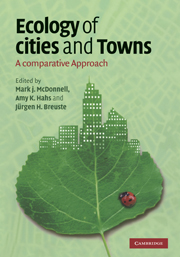Crossref Citations
This Book has been
cited by the following publications. This list is generated based on data provided by Crossref.
Musacchio, Laura R.
2009.
The scientific basis for the design of landscape sustainability: A conceptual framework for translational landscape research and practice of designed landscapes and the six Es of landscape sustainability.
Landscape Ecology,
Vol. 24,
Issue. 8,
p.
993.
2010.
Books and Monographs Received.
Ecology,
Vol. 91,
Issue. 1,
p.
309.
Catterall, Carla P.
Cousin, Jarrad A.
Piper, Scott
and
Johnson, Gayle
2010.
Long‐term dynamics of bird diversity in forest and suburb: decay, turnover or homogenization?.
Diversity and Distributions,
Vol. 16,
Issue. 4,
p.
559.
NATUHARA, Yosihiro
2010.
“Special Issue”Development of the City Biodiversity Index.
Journal of the Japanese Society of Revegetation Technology,
Vol. 36,
Issue. 3,
p.
373.
Lunney, Daniel
2010.
Cities, Nature, Justice: a zoologist's perspective.
Transforming Cultures eJournal,
Vol. 5,
Issue. 1,
Hedblom, Marcus
and
Mörtberg, Ulla
2011.
Urban Remote Sensing.
p.
287.
Jones, Darryl
2011.
An appetite for connection: why we need to understand the effect and value of feeding wild birds.
Emu - Austral Ornithology,
Vol. 111,
Issue. 2,
p.
i.
Bókony, Veronika
Kulcsár, Anna
Tóth, Zoltán
Liker, András
and
McGraw, Kevin
2012.
Personality Traits and Behavioral Syndromes in Differently Urbanized Populations of House Sparrows (Passer domesticus).
PLoS ONE,
Vol. 7,
Issue. 5,
p.
e36639.
Meyer, Spencer R.
Johnson, Michelle L.
and
Lilieholm, Robert J.
2012.
Urban-Rural Interfaces.
p.
225.
Zipperer, Wayne C
and
Pickett, Steward TA
2012.
Encyclopedia of Life Sciences.
Boone, Christopher G.
Cook, Elizabeth
Hall, Sharon J.
Nation, Marcia L.
Grimm, Nancy B.
Raish, Carol B.
Finch, Deborah M.
and
York, Abigail M.
2012.
A comparative gradient approach as a tool for understanding and managing urban ecosystems.
Urban Ecosystems,
Vol. 15,
Issue. 4,
p.
795.
McDonnell, Mark J.
and
Hahs, Amy K.
2013.
The future of urban biodiversity research: Moving beyond the ‘low-hanging fruit’.
Urban Ecosystems,
Vol. 16,
Issue. 3,
p.
397.
Lin, Brenda B.
Fuller, Richard A.
and
Thompson, Des
2013.
FORUM: Sharing or sparing? How should we grow the world's cities?.
Journal of Applied Ecology,
Vol. 50,
Issue. 5,
p.
1161.
Staniūnas, Mindaugas
2013.
Ekologijos aspekto vertinimas miestų bendruosiuose planuose.
Sushinsky, Jessica R.
Rhodes, Jonathan R.
Possingham, Hugh P.
Gill, Tony K.
and
Fuller, Richard A.
2013.
How should we grow cities to minimize their biodiversity impacts?.
Global Change Biology,
Vol. 19,
Issue. 2,
p.
401.
Ignatieva, Maria
and
Ahrné, Karin
2013.
BIODIVERSE GREEN INFRASTRUCTURE FOR THE 21ST CENTURY: FROM “GREEN DESERT” OF LAWNS TO BIOPHILIC CITIES.
JOURNAL OF ARCHITECTURE AND URBANISM,
Vol. 37,
Issue. 1,
p.
1.
Kuitert, Wybe
2013.
Urban landscape systems understood by geo-history map overlay.
Journal of Landscape Architecture,
Vol. 8,
Issue. 1,
p.
54.
Cadenasso, M. L.
and
Pickett, S. T. A.
2013.
Resilience in Ecology and Urban Design.
Vol. 3,
Issue. ,
p.
29.
Cadenasso, M. L.
Pickett, S. T. A.
McGrath, Brian
and
Marshall, Victoria
2013.
Resilience in Ecology and Urban Design.
Vol. 3,
Issue. ,
p.
107.
Felson, Alexander J.
2013.
Resilience in Ecology and Urban Design.
Vol. 3,
Issue. ,
p.
365.



